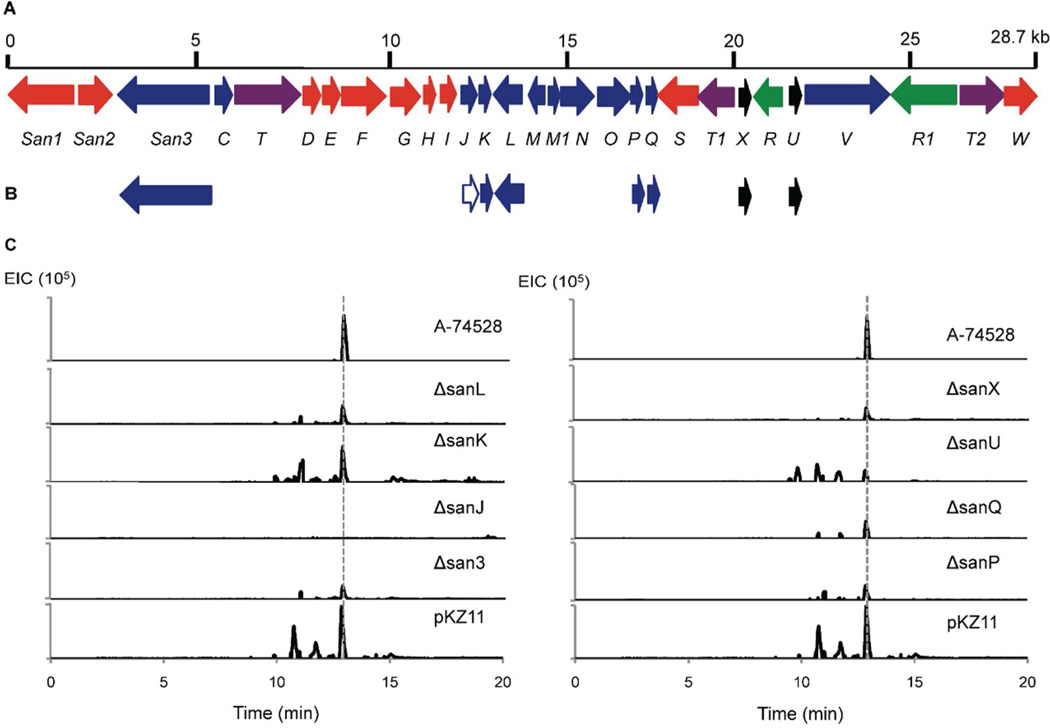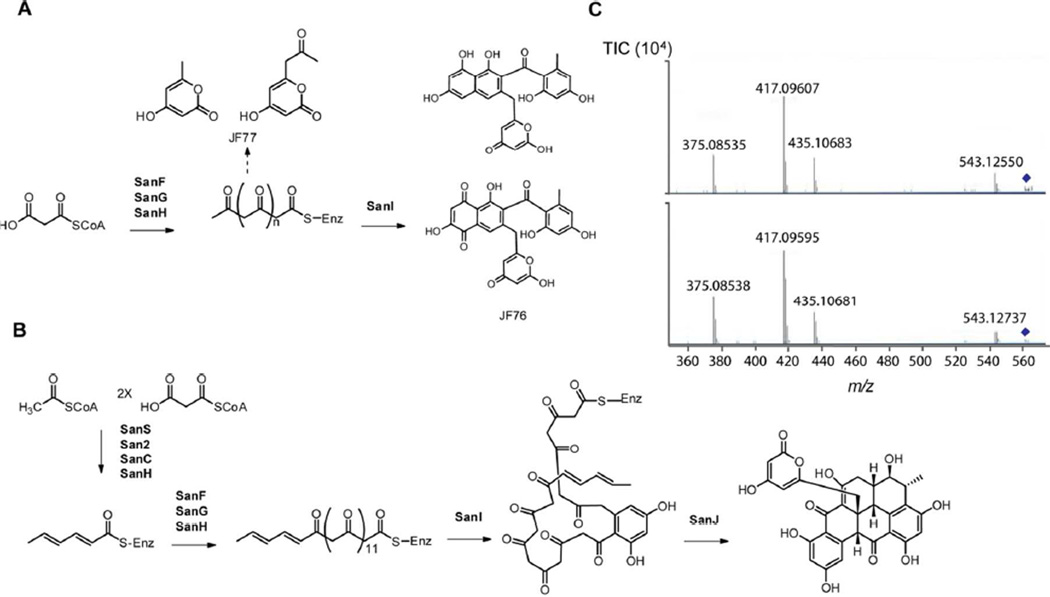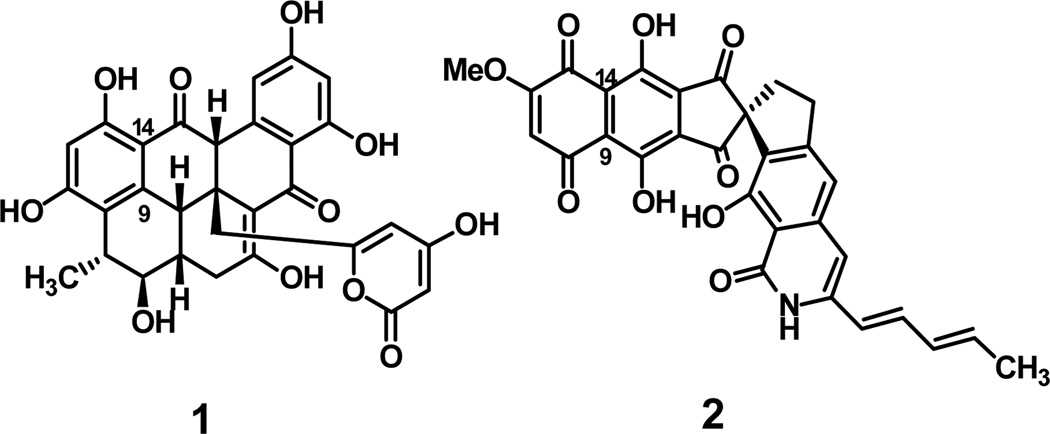Abstract
A-74528 is a C-30 polyketide natural product that functions as an inhibitor of 2′,5′-oligoadenylate phosphodiesterase (2′-PDE), a key regulatory enzyme of the interferon pathway. Modulation of 2′-PDE represents a unique therapeutic approach to regulate viral infections. The gene cluster responsible for biosynthesis of A-74528 yields minute amounts of this natural product together with considerably larger quantities of a structurally dissimilar C-30 cytotoxic agent, fredericamycin. Through construction and analysis of a series of knockout mutants, we identified the necessary genes for A-74528 biosynthesis. Remarkably, the formation of six stereocenters and the regiospecific formation of six rings in A- 74528 appears to be catalyzed by only two tailoring enzymes, a cyclase and an oxygenase, in addition to the core polyketide synthase. The inferred pathway was genetically refactored in a heterologous host, Streptomyces coelicolor CH999, to produce 3 mg/L A-74528 in the absence of fredericamycin.
The development of new antiviral agents is an important goal in contemporary medicinal chemistry. Because viruses typically rely on native cell machinery for their replication, a primary challenge in engineering effective therapeutics is the ability to differentiate between viral and host targets. In this respect, the polyketide A-74528 (1) is a promising antiviral lead. Its unique mode of action entails boosting the native 2–5A antiviral pathway through inhibition of 2',5'-phosphodiesterase (2' PDE).1
We recently cloned and sequenced the san gene cluster responsible for A-74528 production in Streptomyces sp. SANK 61196.2 We also reported heterologous production of A-74528 in Streptomyces lividans K4-114 using cosmid pKZ11, which harbors the entire A-74528 gene cluster except for the putative phosphopantetheinyl transferase sanW.2 In both the native and heterologous systems, A-74528 was produced in impractically low quantities (<< 1 mg/L), a problem that was exacerbated by the copious production of cytotoxic fredericamycin A (2, FDM A; ~100 mg/L)3 by the same san cluster (Figure S1).
In this work, we sought to identify the minimal set of proteins necessary for A-74528 production and to engineer a system capable of producing A-74528 to the exclusion of FDM A. We began by constructing a set of mutants of cosmid pKZ11 in which candidate biosynthetic genes were individually deleted using PCR-targeting. 4 Mutant cosmids were introduced into S. lividans K4-114, and the metabolite profile of the resulting transformants was analyzed. Using this information, we then sought to refactor the minimal A-74528 pathway in the heterologous host Streptomyces coelicolor CH999.5 For these studies, the shuttle vector pRM5 was used,5 as it allows for a greater degree of control over enzyme expression than pKZ11.
The san gene cluster encodes a putative ketosynthase/chain length factor heterodimer (KS/CLF; sanFG), an acyl carrier protein (ACP; sanH), and a phosphopantetheinyl transferase (sanW).6 Aside from these crucial genes, the san cluster also harbors a putative C9-C14 cyclase (sanI) and an initiation module (sanS2C). All of these proteins were presumed to be required for both A-74528 and FDM A production. (See Supplementary Information for a complete list of genes and putative functions (Table S2), as well as proposed pathways to A-74528 (Scheme S2) and FDM A (Scheme S1).) A number of additional genes encode putative regulatory proteins and transporters (sanTT1T2RR1). Lastly, based on the work of Shen and coworkers,7,8 some genes were thought to be specific to FDM A production (sanMM1VED), and were thus presumed to lie downstream of the branch point between the FDM A and A-74528 pathways. We therefore focused on the remaining genes, including five putative oxygenases (sanJKLPQ3), a ketoreductase (sanO), and two genes of unknown function (sanUX).
In-frame deletion mutants of pKZ11 were constructed using the previously described PCR-targeting system and FLPrecombination (for details, see Supplementary Information).4 The metabolite profile of each mutant plasmid was analyzed by extracting at least ten plates of the corresponding S. lividans K4-114 transformant with organic solvent. (For details, see Supplementary Information.)
We had previously hypothesized that the protein product of sanX may play a role in A-74528 production.2 This gene is the only qualitative difference between the fdm cluster in S. griseus, which exclusively produces FDM A, and the san cluster in S. SANK 61196, which produces both FDM A and A-74528. Surprisingly, the sanX knockout retained the ability to produce A-74528 (Figure 2C). This led us to speculate that a more subtle difference controls the branch point between the FDM A and A-74528 pathways. (All other genes in the san cluster bear >80% sequence identity to their homologs in the fdm cluster.)
Figure 2.
PCR targeting of pKZ11, harboring the biosynthetic genes necessary for A-74528 production. A) The 28.7 kb san gene cluster encodes for PKS and associated genes (red), tailoring genes (blue), resistance genes (purple), regulatory genes (green), and genes of unknown function (black). B) Genes encoding oxygenases and enzymes of unknown function were individually disrupted by PCR-targeting. Only sanJ was found to be essential for A-74528 biosynthesis. C) LC-MS analysis of extracts isolated from the mutant strains revealed the presence of A-74528 in most secondary metabolite extracts but not in pKZ11/ΔsanJ. The extracted ion chromatogram (EIC) for the positive ion of A-74528 ([M+H]+ 561.1–561.15) is shown on the Y-axis. Traces for pKZ11, ΔsanJ, ΔsanU, and ΔsanQ are extracts derived from liquid cultures followed by ammonium sulfate precipitation, and are analyzed at 50 mg/mL. Traces for Δsan3, ΔsanK, ΔsanL, ΔsanP, and ΔsanX are derived from agar plate cultures, analyzed at 25 mg/mL. See SI for experimental details.
As shown in Figure 2, the putative oxygenase, SanJ, is the only protein among those tested that is necessary for A-74528 biosynthesis. None of the other oxygenases (SanK, SanL, SanP, SanQ, or San3) are essential, nor is the ketoreductase (SanO) or the protein of unknown function (SanU). Because FDM A (but not A-74528) biosynthesis requires reduction of the C19 ketone of the putative polyketide backbone, we correctly anticipated that the ΔsanO mutant would not produce FDM A (Figure S5).
The above finding is consistent with our hypothesis (Scheme S2) that only one oxygenation is required at the C28 position for A-74528 biosynthesis, whereas several other oxygenation reactions occur in the pathway leading to FDM A.8 Oddly, the ΔsanK, ΔsanL, ΔsanP, ΔsanQ and Δsan3 mutants retained some ability to produce FDM A (Figure S4). This may be due to partially redundant function of the oxygenases, not unlike what has previously been observed in the oxytetracycline system.9
To test our hypothesis that A-74528 biosynthesis requires sanJ, we sought to refactor the minimal pathway for this antiviral agent in Streptomyces coelicolor CH999. Genes for the minimal PKS (sanFGH), the C9-C14 cyclase (sanI), the oxygenase (sanJ) as well as the initiation module (sanS2C) were cloned from pKZ11 using primers described in Table S1. Separately, the gene for the phosphopantetheinyl transferase (sanW) was amplified from pKZ2.2 These genes were then assembled into small segments using PCR SOEing,10 and ligated into intermediate vectors. These segments were then transferred into pRM5 (see SI for details). Three constructs were obtained – the minimal PKS sanFGHW (pJF77); the minimal PKS, initiation module, and the C9-C14 cyclase, sanFGHWIXS2C (pJF76); and one that also included sanJ, sanFGHWIS2CJ (pJF111, see Notes).
Each plasmid was introduced into S. coelicolor CH999/pBOOST*11 yielding strains CH999/pBOOST*/pJF77, CH999/pBOOST*/pJF76, and CH999/pBOOST*/pJF111. Each strain was grown on semi-solid agar medium (500 mL for analytical purposes, or 3 L for compound isolation and characterization). The medium was then extracted with equal volumes of a 1% AcOH, 10% MeOH, 89% EtOAc solution overnight. Small-scale extracts were evaporated to dryness and re-suspended in methanol for analysis by Q-TOF LC-MS. For characterization of major metabolites, C18 solid phase extraction cartridges and preparative HPLC was used to purify individual molecules (Supporting Information).
The pigmentation pattern of S. coelicolor CH999/pBOOST*/pJF77 (yellow/orange) was distinct from the brown/black pigment produced by the other two strains. Unsurprisingly, it also did not produce A-74528, as gauged by LC-MS analysis (Figure S6). It lacked any major products with absorbance at both 280 and 350 nm (wavelengths at which many conjugated, oxygenated, aromatic compounds appear (Figure S2)). The only isolable compounds from this strain were previously reported tri- and tetra-ketides (Figure 3A).12 Although the absence of longer-chain polyketides cannot be definitively interpreted, it appears that the minimal PKS lacks auxiliary subunits that allow the KS/CLF to fashion a binding site for the growth of longer polyketide chains.
Figure 3.
Refactoring A-74528 biosynthesis in S. coelicolor CH999. A) Strains harboring the minimal PKS enzymes (CH999/pBOOST*/pJF77) produced tri- and tetraketide shunt products. Upon the addition of the initiation module and first ring cyclase enzymes (CH999/pBOOST*/pJF76), the dodecaketides TW95a and TW95b are observed. In this case the initiation module appears to have failed to provide the appropriate hexadienyl starting unit to this major polyketide product. B) Proper function of the initiation module along with addition of the oxygenase SanJ (CH999/pBOOST*/pJF111) afforded a strain capable of producing A-74528. As in previous work, 15 the origins of the hexadienyl starting unit remain unclear but are shown as acetyl-CoA and malonyl-CoA here for simplicity. C) LC-MS/MS confirmed the identity of A-74528 produced by CH999/pBOOST*/pJF111 (top panel) through comparison to an authentic standard (bottom panel). The diamond represents the A-74528 parent ion.
In addition to the minimal PKS, S. coelicolor CH999/pBOOST*/pJF76 also harbors the initiation module and the C9-C14 cyclase. It produced a more instructive polyketide mixture than the minimal construct alone, although it too was unable to produce A-74528 (Figure S6). In addition to the tri- and tetra-ketide products produced by CH999/pBOOST*/pJF77, the strain harboring pJF76 produced two new peaks which absorb at 280 and 350 nm. These peaks match the retention time and UV signature of TW95a and TW95b (Figure S2), two known dodecaketides originally isolated from strains harboring the whiE minimal PKS and the whiE C9-C14 cyclase.13 Production of these dodecaketides has three significant implications for the san KS/CLF. First, as has been seen with other type II PKSs that have the capacity to synthesize very long chain products, auxiliary enzyme components can be presumed to modulate the chain length specificity of the san KS/CLF.12,14 Second, although TW95a and TW95b are produced in small quantities by this strain, the product profile remains similar to JF77 (Figure S2), indicating that long chain polyketide formation is inefficient. Third, the lack of any identifiable hexadienyl-primed products indicates that priming of the minimal PKS by the initiation module is either inefficient, or does not occur at all in this construct.
S. coelicolor CH999/pBOOST*/pJF111 differs from its counterpart harboring pJF76 by only the putative sanJ oxygenase gene. It produced A-74528 (Figures 3C, S6, S7, and Table S5), confirming our hypothesis that sanJ is indeed required for production of this metabolite. The strain produced isolable quantities of A-74528 from a standard agar extraction (titer estimated at 3 mg/L in comparison with an authentic reference standard). This quantity of A-74528 was previously inaccessible from both the native S. sp. SANK 61196 and the heterologous S. lividans K4114/pKZ11 expression strain, both of which produced quantities too small to be easily isolated. Unfortunately, A-74528 remains a relatively minor product of S. coelicolor CH999/pBOOST*/pJF111; the strain also yields larger quantities of other shunt metabolites including TW95a and TW95b (Figure S2). Thus, efficient priming of the minimal PKS remains a problem.
Our analysis of the san cluster has provided unexpected and interesting new insights into the biosynthesis and tailoring of one of the longest and most intricately fashioned polyketides made by a Type II PKS. Remarkably, the formation of six stereocenters and the regiospecific formation of six rings in A-74528 appears to occur through the action of only two tailoring enzymes, the C9- C14 cyclase, SanI, and the putative oxygenase, SanJ. It is of course possible that the minimal PKS also aids in fashioning the natural product. Thus, the paradigm in which chain length, primer unit selection and the regiospecificity of cyclization are modularly controlled appears to need modification when very large chains and complex priming units are involved. Further studies are warranted to understand this interplay between enzyme-substrate and protein-protein interactions.
Supplementary Material
Figure 1.
The products of the san gene cluster A-74528 (1) and FDM A (2). The C9 and C14 positions on both molecules are labeled to highlight the extent of similarity in cyclization pattern between the two.
ACKNOWLEDGMENT
We thank Dr. Elizabeth Sattely for advice and access to LC/MS (NIH grant R00GM089985 and Stanford SoE). L.K.C. was supported by a postdoctoral fellowship (F32 CA137944) from the National Cancer Institute. K.R.W. is a recipient of an NIH Institutional Research and Academic Career Development Postdoctoral Award (NIH K12-GM088033). This work was supported by a grant from the National Institutes of Health (R01 CA 077248) to C.K.
Footnotes
ASSOCIATED CONTENT
Supporting Information
Experimental procedures, and compound characterizations. This material is available free of charge via the ACS website, http://pubs.acs.org.
Notes
The gene sanX is not included in pJF111, though it was present in pJF76, and was found to have no effect on A-74528 production.
REFERENCES
- 1.Silverman RH. Biochemistry. 2003;42:1805–1812. doi: 10.1021/bi027147i. [DOI] [PubMed] [Google Scholar]
- 2.Zaleta-Rivera K, Charkoudian LK, Ridley CP, Khosla C. J Am Chem Soc. 2010;132:9122–9128. doi: 10.1021/ja102519v. [DOI] [PMC free article] [PubMed] [Google Scholar]
- 3.Wendt-Pienkowski E, Huang Y, Jian Zhang, Li B, Jiang H, Kwon H, Hutchinson CR, Shen B. J Am Chem Soc. 2005;127:16442–16452. doi: 10.1021/ja054376u. [DOI] [PubMed] [Google Scholar]
- 4.Gust B, Kieser T, Chater KF. REDIRECT Technology. PCR Targeting Systems in Streptomyces coelicolor. Colney Norwich NR4 7UH U.K: John Innes Centre: Norwich Research Park; 2002. [Google Scholar]
- 5.McDaniel R, Ebert-Khosla S, Hopwood D, Khosla C. Science. 1993;262:1546–1550. doi: 10.1126/science.8248802. [DOI] [PubMed] [Google Scholar]
- 6.Das A, Khosla C. Accounts Chem Res. 2009;42:631–639. doi: 10.1021/ar8002249. [DOI] [PMC free article] [PubMed] [Google Scholar]
- 7.Chen Y, Wendt-Pienkowski E, Ju J, Lin S, Rajski SR, Shen B. J Biol Chem. 2010;285:38853–38860. doi: 10.1074/jbc.M110.147744. [DOI] [PMC free article] [PubMed] [Google Scholar]
- 8.Chen Y, Wendt-Pienkoski E, Rajski SR, Shen B. J Biol Chem. 2009;284:24735. doi: 10.1074/jbc.M109.014191. [DOI] [PMC free article] [PubMed] [Google Scholar]
- 9.Wang P, Zhang W, Zhan J, Tang Y. ChemBioChem. 2009;10:1544–1550. doi: 10.1002/cbic.200900122. [DOI] [PubMed] [Google Scholar]
- 10.Horton R, Hunt H, Ho S, Pullen J, Pease L. Gene. 1989;77:61–68. doi: 10.1016/0378-1119(89)90359-4. [DOI] [PubMed] [Google Scholar]
- 11.Hu Z, Hopwood DA, Hutchinson CR. J Ind Microbiol Biot. 2003;30:516–522. doi: 10.1007/s10295-003-0064-y. [DOI] [PubMed] [Google Scholar]
- 12.Das A, Khosla C. Chem Biol. 2009;16:1197–1207. doi: 10.1016/j.chembiol.2009.11.005. [DOI] [PMC free article] [PubMed] [Google Scholar]
- 13.Yu T-W, Shen Y, McDaniel R, Floss HG, Khosla C, Hopwood DA, Moore BS. J Am Chem Soc. 1998;120:7749–7759. [Google Scholar]
- 14.Szu PH, Govindarajan S, Meehan MJ, Das A, Nguyen DD, Dorrestein PC, Minshull J, Khosla C. Chem Biol. 2011;18:1021–1031. doi: 10.1016/j.chembiol.2011.07.015. [DOI] [PMC free article] [PubMed] [Google Scholar]
- 15.Das A, Szu PH, Fitzgerald JT, Khosla C. J Am Chem Soc. 2010;132:8831–8833. doi: 10.1021/ja102517q. [DOI] [PMC free article] [PubMed] [Google Scholar]
Associated Data
This section collects any data citations, data availability statements, or supplementary materials included in this article.





